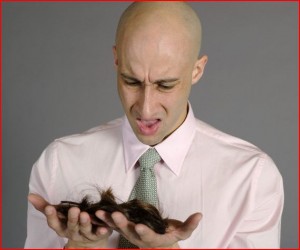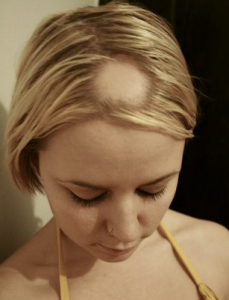About Hair Loss
Friday, October 21st, 2011 Hair loss and hair thinning is a result of testosterone formed in different areas like the prostate gland or hair follicles, which is converted to Dihydrotestosterone (DHT) in the scalp area. Hair follicles prone to genetic male patterned baldness contain DHT receptors, thus thinning hair and loss of hair can result. Over time men produce an abundance of DHT and the molecules affect their hair follicles and cause a decrease in size and eventually see their natural hair fall out permanently. Because of this common occurrence, hair loss in men is frequent.
Hair loss and hair thinning is a result of testosterone formed in different areas like the prostate gland or hair follicles, which is converted to Dihydrotestosterone (DHT) in the scalp area. Hair follicles prone to genetic male patterned baldness contain DHT receptors, thus thinning hair and loss of hair can result. Over time men produce an abundance of DHT and the molecules affect their hair follicles and cause a decrease in size and eventually see their natural hair fall out permanently. Because of this common occurrence, hair loss in men is frequent.
DHT and hair loss from having the gene for male pattern baldness are the most common factors for male pattern baldness. Women suffering from female-pattern baldness, unlike their counterparts with male-pattern baldness, are not usually characterized by higher production rates of DHT from lower levels of testosterone. On the other hand, if for a number of possible reasons, a woman has increased testosterone, she can develop female patterned baldness like a man does through the same mechanism.
Hair in the prone areas to male patterned baldness: Corners, top, and crown are filled with DHT receptors in men who suffer Androgenic Alopecia The hair on donor areas such as back and sides, however, have fewer DHT receptors. This is precisely why hair is more permanent on the sides and back and not the top and front.

The distinction in the hair quality of different areas, such as the donor and recipient areas, allows for hair loss surgeons to remove the hair from one area and transplant it to the bald portions of the scalp. These newly transplanted hairs are permanent and immune to DHT. Finasteride (Propecia) is a drug which blocks the conversion of testosterone to DHT as a result of it blocking the enzyme alpha reductase. The amount of DHT in hair loss patients decrease when they are on Propecia and this helps to maintain healthy hair, and also helps some of the miniaturized hair become stronger.
We at US Hair Restoration often recommend medical treatment with DHT blockers in many of our patients who undergo a hair transplantation procedure in order to help maintain their own hair in addition to the newly restored, formerly balding areas because of a hair restoration surgery.

